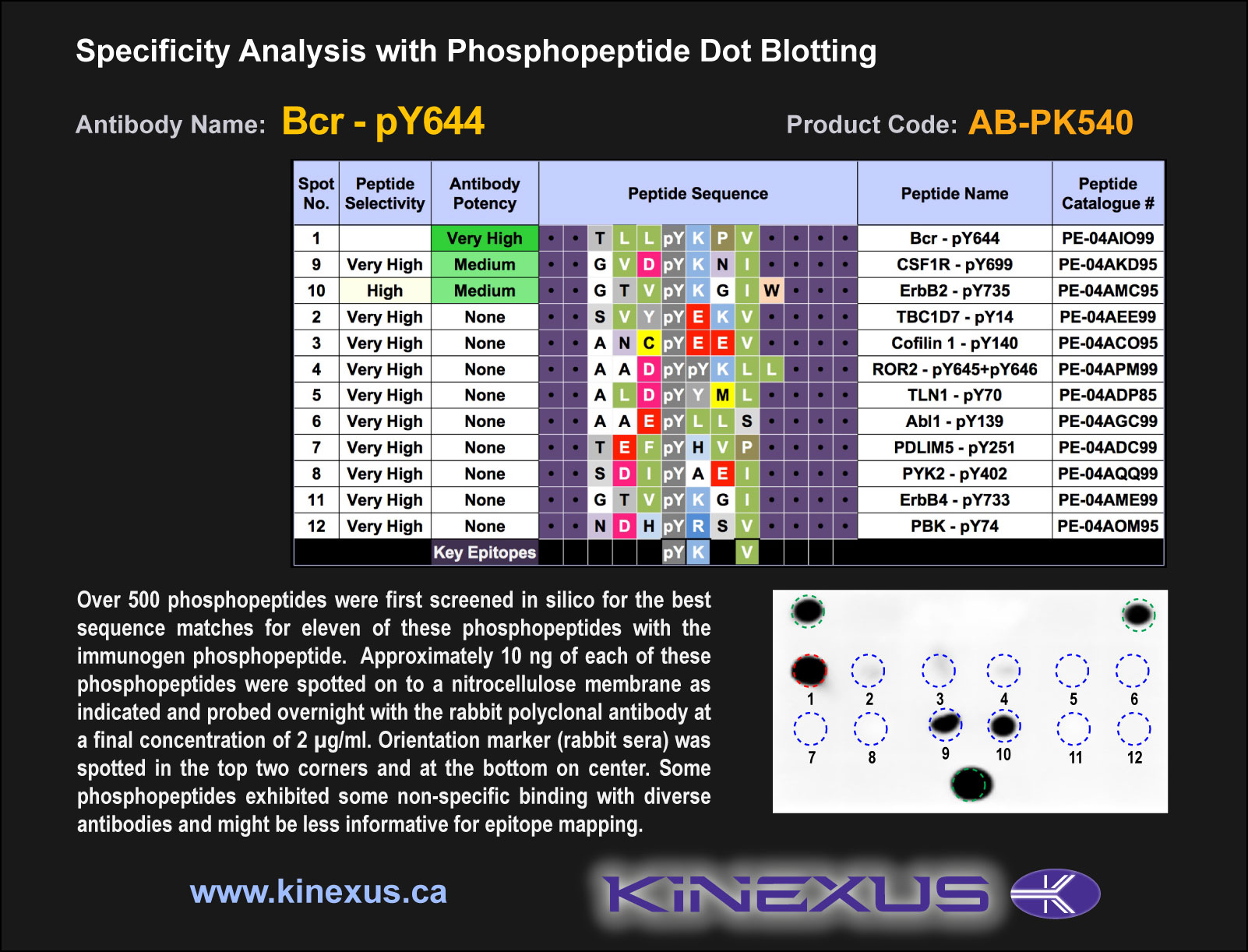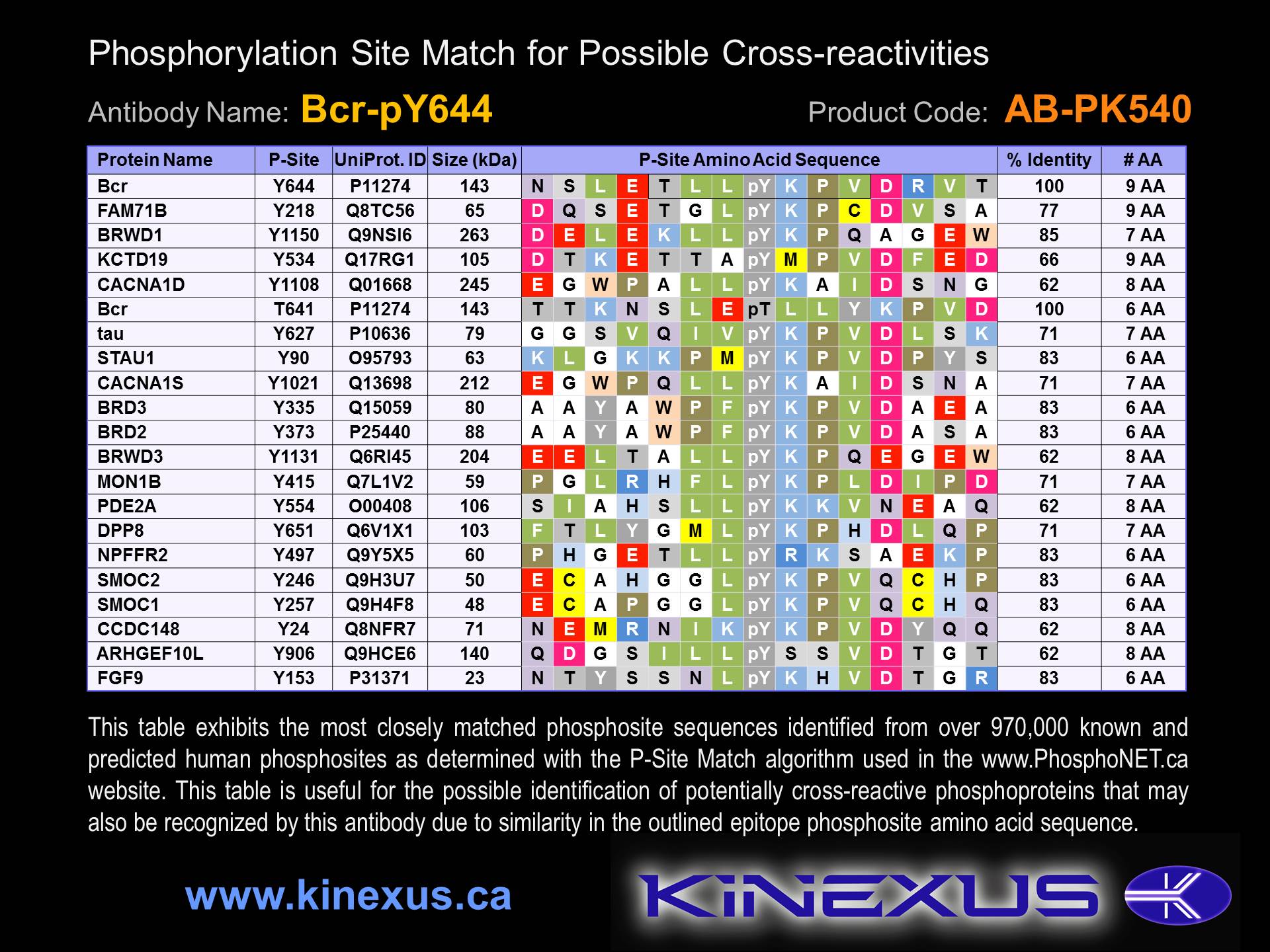Product Name: Bcr-pY644
Product Number: AB-PK540
| Size: | 25 µg | Price: | 89.00 | |
| $US |
Target Full Name: Breakpoint cluster region protein
Target Alias: ALL; BCR; BCR1; Breakpoint cluster region; CML; D22S11; D22S662; PHL; Renal carcinoma antigen NY-REN-26; FLJ16453; CCDS13806.1; Q12843; Q12845; Q12848; Q14020; Q13846; ENSG00000186716
Product Type Specific: Protein kinase phosphosite-specific antibody
Antibody Code: PK540
Antibody Target Type: Phosphosite-specific
Antibody Phosphosite: Y644
Protein UniProt: P11274
Protein SigNET: P11274
Antibody Type: Polyclonal
Antibody Host Species: Rabbit
Target Alias: ALL; BCR; BCR1; Breakpoint cluster region; CML; D22S11; D22S662; PHL; Renal carcinoma antigen NY-REN-26; FLJ16453; CCDS13806.1; Q12843; Q12845; Q12848; Q14020; Q13846; ENSG00000186716
Product Type Specific: Protein kinase phosphosite-specific antibody
Antibody Code: PK540
Antibody Target Type: Phosphosite-specific
Antibody Phosphosite: Y644
Protein UniProt: P11274
Protein SigNET: P11274
Antibody Type: Polyclonal
Antibody Host Species: Rabbit
Antibody Immunogen Source: Human Bcr sequence peptide Cat. No.: PE-04AIO99
Antibody Immunogen Sequence: TLL(pY)KPV(bA)C
Antibody Immunogen Description: Corresponds to amino acid residues T641 to V647; In the Rho-GEF domain. One of the main in vivo phosphorylation sites in Bcr.
Antibody Immunogen Sequence: TLL(pY)KPV(bA)C
Antibody Immunogen Description: Corresponds to amino acid residues T641 to V647; In the Rho-GEF domain. One of the main in vivo phosphorylation sites in Bcr.
Production Method: The immunizing peptide was produced by solid phase synthesis on a multipep peptide synthesizer and purified by reverse-phase hplc chromatography. Purity was assessed by analytical hplc and the amino acid sequence confirmed by mass spectrometry analysis. This peptide was coupled to KLH prior to immunization into rabbits. New Zealand White rabbits were subcutaneously injected with KLH-coupled immunizing peptide every 4 weeks for 4 months. The sera from these animals was applied onto an agarose column to which the immunogen peptide was thio-linked. Antibody was eluted from the column with 0.1 M glycine, pH 2.5. Subsequently, the antibody solution was neutralized to pH 7.0 with saturated Tris.This antibody was also subject to negative purification over phosphotyrosine-agarose.
Antibody Modification: Unconjugated. Contact KInexus if you are interest in having the antibody biotinylated or coupled with fluorescent dyes.
Antibody Modification: Unconjugated. Contact KInexus if you are interest in having the antibody biotinylated or coupled with fluorescent dyes.
Antibody Concentration: 1 mg/ml
Storage Buffer: Phosphate buffered saline pH 7.4, 0.05% Thimerasol
Storage Conditions: For long term storage, keep frozen at -40°C or lower. Stock solution can be kept at +4°C for more than 3 months. Avoid repeated freeze-thaw cycles.
Product Use: Western blotting | Antibody microarray
Antibody Dilution Recommended: 2 µg/ml for immunoblotting
Antibody Potency: Very strong immunoreactivity with immunogen peptide on dot blots.
Antibody Species Reactivity: Human
Antibody Positive Control: The observed molecular mass of the processed target protein on SDS-PAGE gels is reported to be around 150-170 kDa.
Storage Buffer: Phosphate buffered saline pH 7.4, 0.05% Thimerasol
Storage Conditions: For long term storage, keep frozen at -40°C or lower. Stock solution can be kept at +4°C for more than 3 months. Avoid repeated freeze-thaw cycles.
Product Use: Western blotting | Antibody microarray
Antibody Dilution Recommended: 2 µg/ml for immunoblotting
Antibody Potency: Very strong immunoreactivity with immunogen peptide on dot blots.
Antibody Species Reactivity: Human
Antibody Positive Control: The observed molecular mass of the processed target protein on SDS-PAGE gels is reported to be around 150-170 kDa.
Antibody Specificity: Very high
Antibody Cross Reactivity: No cross-reactivities with other proteins in A431 and Jurkat cells, and sea star oocytes, but a weak 48 kDa cross-reactive protein was detected in A431 cells.
Related Product 1: Bcr-pY644 blocking peptide
Related Product 2: Bcr-pY177 phosphosite-specific antibody (Cat. No.: AB-PK538)
Related Product 3: Bcr-pY591 phosphosite-specific antibody (Cat. No.: AB-PK539)
Antibody Cross Reactivity: No cross-reactivities with other proteins in A431 and Jurkat cells, and sea star oocytes, but a weak 48 kDa cross-reactive protein was detected in A431 cells.
Related Product 1: Bcr-pY644 blocking peptide
Related Product 2: Bcr-pY177 phosphosite-specific antibody (Cat. No.: AB-PK538)
Related Product 3: Bcr-pY591 phosphosite-specific antibody (Cat. No.: AB-PK539)
Scientific Background: Bcr (BCR1, breakpoint cluster region) is a protein-serine/threonine kinase of the Atypical group and BCR family. It features a protein-serine/threonine kinase domain at its N-terminus and also acts as a GTPase-activating protein for Rac1 and Cdc42 by virtue of a C-terminal domain. Bcr promotes the exchange of Rac1 or Cdc42-bound GDP by GTP, thereby activating them. It is ubiquitously expressed, with highest expression in brain and hematopoietic tissue. The function of physiological Bcr is unclear. Bcr appears to be an oncoprotein (OP). The Bcr gene is located on chromosome 22q11. 2, which is the site of a common breakpoint for chromosomal translocations commonly found in specific human cancers. These chromosomal translocations are observed in chronic myeloid leukemia (CML) and acute lymphocytic leukemia (ALL) and produce two alternative forms of the Philadelphia chromosome, in which different sets of exons from the Bcr gene are joined to a common group of exons from the Abl1 gene. This creates two chimeric oncogene products referred to as p210(Bcr-Abl) and p185(Bcr-Abl), which both display oncogenic tyrosine kinase activity. The inhibtion of myeloid precursor cell differentiation is a key feature of the cancer progression in patients with CML that express the p210(Bcr-Abl) oncoprotein. This differentiation arrest is mediated through the transcriptional suppression of the granulocyte-stimulating factor receptor (CSF3R) gene through phosphorylation by the Abl kinase domain of the fusion protein. In animal studies, transplantation of a retrovirus encoding the p210(Bcr-Abl) oncoprotein into irradiated immuno-deficient mice induced hematologic malignancies with similar features as human leukemia, specifically CML. Insertional mutagenesis studies in mice also support a role for this protein kinase in mouse cancer oncogenesis.
Figure 1. Epitope mapping of Bcr-pY644 antibody with similar phosphopeptides on dot blots.
Figure 2. Identification of phosphosites related to Bcr-pY644.
© Kinexus Bioinformatics Corporation 2017



